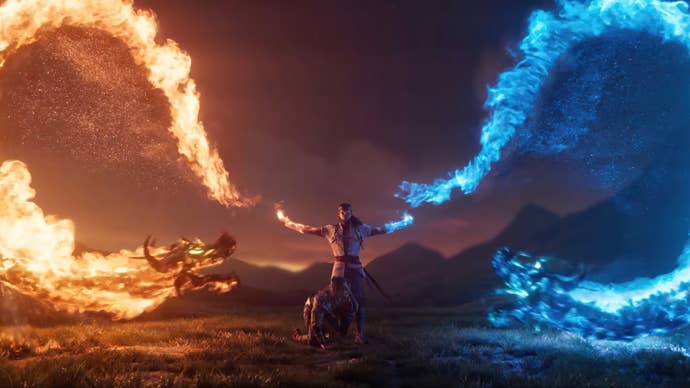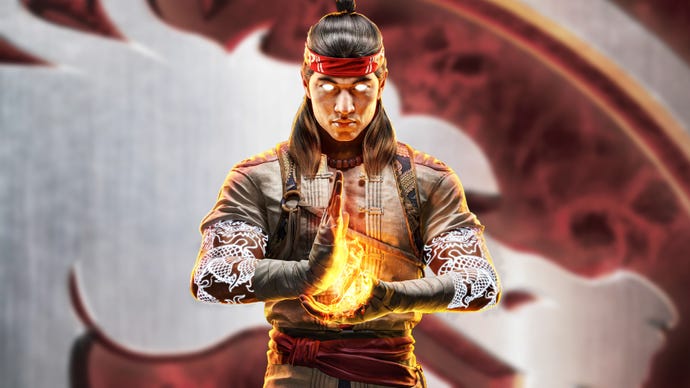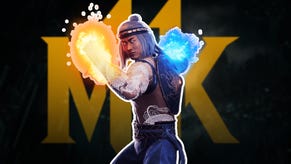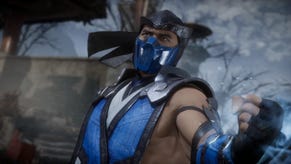Mortal Kombat 1 draws a surprising amount from the series’ PS2 era – and it’s brilliant
The two main reference points that I can see working in Mortal Kombat 1 are Mortal Kombat X and Mortal Kombat Armageddon. Yes, really.
The one big difference between Mortal Kombat 1 and what’s come before – well, what’s come in the last decade-plus, at least – is the aerial game. So much of the game revolves around the gap in the air; the battle screen has even been pulled back slightly to accommodate a nice big chunk of space above your fighters’ heads to ensure there’s room for a nasty little melee dogfight or two up there.
“There has not been a proper aerial game in Mortal Kombat since Mortal Kombat Armageddon, which was nearly 20 years ago,” laughs Derek Kirtzic, lead systems designer at NetherRealm studios. “I am a huge MK fan, and for me this aerial kombat – that’s kombat with a K – was the thing I was most excited about seeing the players see and get their hands on.” The PS2 game introduced an air combo system and a parry system, neither of which really made it back into the series in any meaningful way. Until now.
Kirtzic goes on to say that a lot of fighting games don’t really lean into this air-based system as much – you may have bound in Tekken that helps keep an opponent off the floor, and some nasty aerial specials or extensions in Street Fighter, but outside of DragonBall FighterZ and some touch of death stuff in Guilty Gear, a lot of fighters keep you glued to the floor these days.
“Between encouraging the aerial stuff and the Kameo system, seeing what you can do with extending your combos in the air and how freeform it is with extensions and juggling… it’s so refreshing!” Kirtzic’s enthusiasm is contagious; he ushers me from the interview room and over to a booth where the game is set up. We were talking rushdown characters, so he sets up a now very aggressive and pressure-heavy Sub Zero to show off what he’s talking about.

In your hands, you can tell that this game wants you in the air; each character that I played with (Kenshi, Sub-Zero, Kitana, Liu Kang) has an aerial ‘get off me’ – a nice sharp, quick move that pops anyone on top of you into the air. From here, each Kameo fighter can come flying in quite high, keeping your opponent airbourne as you recover and set up something else.
This was about as much as I could do without getting time in the lab, but Kirtzic… well, you can tell he’s a master. With a pairing of Sub-Zero and Sonya, he managed to push a poor Kenshi into the corner; an Ice Slide knocked Kenshi back, a Sonya projectile pushed him into the corner, and a hop-in triple hit lead the way nicely to an Ice Ball. It looked so easy.
“Sub-Zero is kind-of an in-your-face character right now; if you [heavy up attack], into a [light combo], you can then call Sonya in and she’ll bounce them back into the air where you can follow up into another combo, then you can land into a ground slide and push them into the corner and put them into pressure.” Watching him do this, in action, really shows you what NetherRealm wants to do with this game; it’s about calling in those Kameos and finding when they can carry on strings that your main fighter can’t do themselves because of recovery frames.

But what happens if you’re the poor idiot that got pressed into the corner? You don’t want to spend 30 seconds straight watching your health bar corrode and fade away to nothing. Well, that’s where one of Mortal Kombat X’s best features comes in: Kombo Breakers. Simply hold block and press towards your opponent, and you’ll use meter to get them off you. No mess, no fuss.
“We need Kombo Breakers in this game,” says Kirtzic. “They reset you to neutral. We’re not using interactables or anything like that here, the Kombo Breaker system is what you’ll use to get out of corners and reset you back to neutral.” That’s not how Breakers worked back in MKX – they simply got you out of a chain, rather than got you back into the centre of the stage. It’s a very anti-corner tool, here, and the best option you have to launch a counter-offensive.
“It’s like we have taken some of the best bits from previous MK games, and we’ve also just taken the bits that make the most sense,” Kirtzic continues. “MK11 we had the breakaway system and perfect block, then we had the different type of wakeup attacks – now we’re doing traditional wake-up attacks that have armour, and that kind of thing. Mortal Kombat 1 is a little bit of A, a little bit of B, a little bit of C.”

And it’s a good mix. It feels good in the hands, though I’d wager it’s perhaps a little bit less accessible than other Mortal Kombat games in the last few years (which is an odd status, given how beginner-friendly Street Fighter is getting these days). It plays well, though, and looks absolutely gorgeous, too. The over-the-top violence is intact, and some of the new character models and animations are butter-smooth and just look astounding.
NetherRealm has upgraded its engine, and when it’s all running at full power, this looks like the new-gen fighter we’ve all been waiting for. Between this, Tekken 8, and Street Fighter 6, there has never been a better time to be a fighting game fan. There’s a little bit of something for everyone – even those that are really into the PS2 era of Mortal Kombat.
Mortal Kombat 1 will release on September 19 for PC, PS5, Switch, and Xbox Series X/S.



.jpg?width=291&height=164&fit=crop&quality=80&format=jpg&auto=webp)






